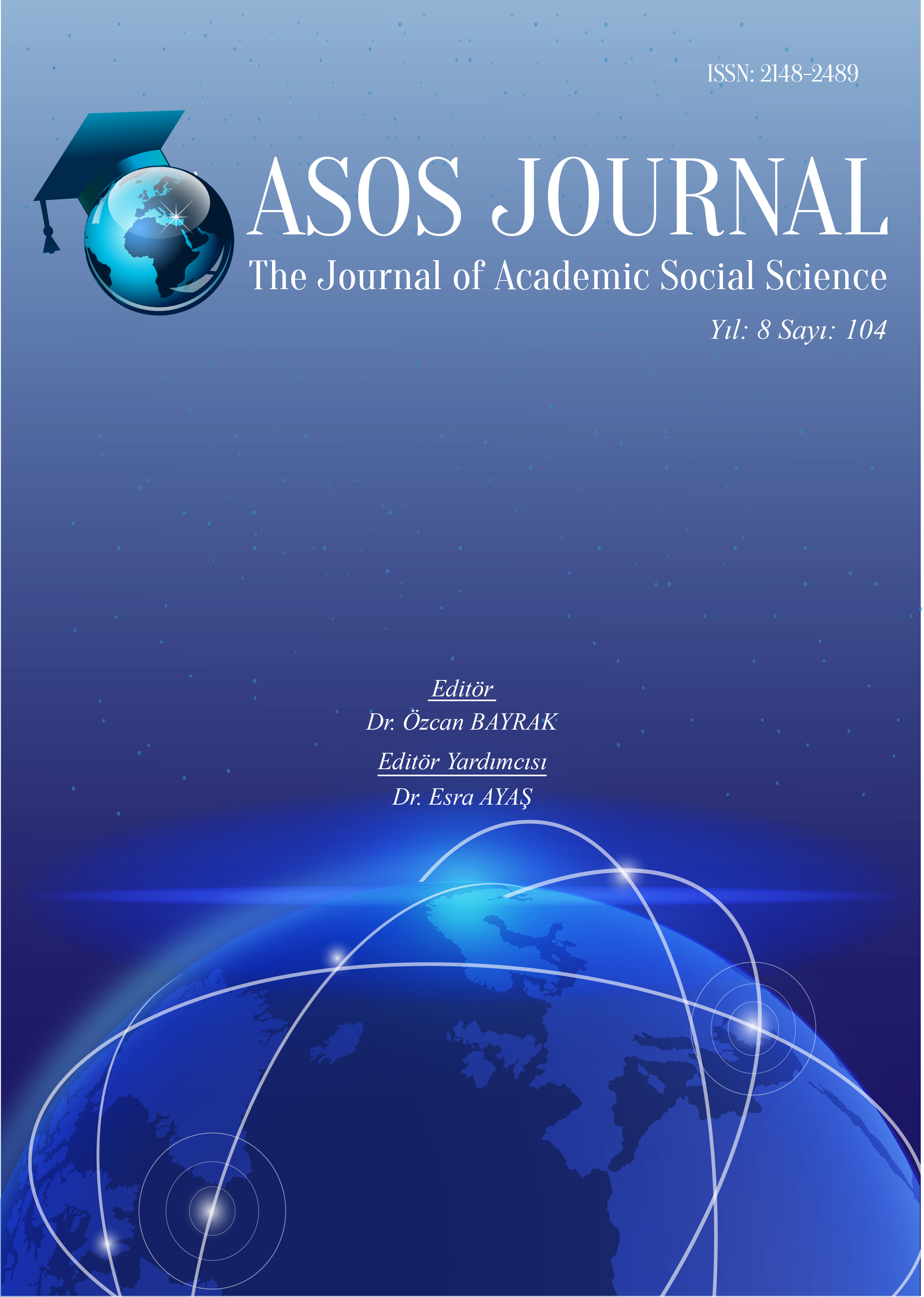AHLAT HASAN PADİŞAH KÜMBETİNDE KULLANILAN GÜLBEZEKLERDEKİ KOMPOZİSYONLARIN ÇİNİ YÜZEYLERE UYGULANMASI
Author :
Abstract
Ahlat, XII. yy ortalarından XV. yy ortalarına kadar önemli bir ilim, ticaret ve sanat merkezi olmuştur. Sanatın her alanında bir ekol olan Ahlat’lı sanatçıların, mezar taşlarında görülen taş ustaları olmalarının yanı sıra, aynı zamanda mimar oldukları ve bu alanda da önemli eserlere imza attıkları kümbetlerin üzerinde yer alan mimar imzalarından anlaşılmaktadır. Makalemizin konusu olan Hasan Padişah kümbeti de süsleme ve mimari açısından Ahlat’ta ki en önemli yapılardan biridir. İlçe merkezinde Taht-ı Süleyman mahallesinde bulunan kümbet; iki katlı olup, kare formlu kaide kenarları pahlanarak on iki köşeli bir alt yapı üzerinde yükselmektedir. Yapı, silindirik bir gövde ve yine silindirik bir külah ile nihayetlenmiştir. Düzgün kesme taş malzemeden inşa edilen kümbetin dış cephesinde ki taş süsleme oldukça dikkat çekicidir. Dıştan geometrik örgülü geniş bordürün iç kısmında yine geometrik ve rumi motiflerinden oluşan gülbezek formları yer almaktadır. Bu makalede yapıda kullanılan gülbezekler de ki geometrik ve rumi motiflerden oluşmuş kompozisyonlar tespit edilerek, yeniden düzenlenmiş ve çini yüzeylere uygulanmıştır. Selçuklu çinilerinde görülen firuze, kobalt mavi, siyah ve patlıcan moru renkler kullanılarak tasarımlar renklendirilmiş ve sır altı tekniği uygulanarak fırınlanmıştır. Bunun yanı sıra bazı çalışmalarda renkli sır tekniği kullanılmıştır. Taş süslemedeki zengin motif ve kompozisyon anlayışı çiniye aktarılarak yeni tasarımlar elde etmek hedeflenmiştir.
Keywords
Abstract
Ahlat had been a great hub for science, trade and art from mid-12 th century to mid -15 th century. It is under understood that artists from Ahlat who had been an idol in every field of art, were the stone masters seen on the gravestones and they were also architects. It is also understood from the architect signatures on the tombs that they succeeded significant works in this field as well. Hasan Sultan Tomb which is the subject of our article, is one of the most important buildings in Ahlat in terms of its ornamentation and architecture. Located in Taht-ı Süleyman Street in the center of the district, the tomb consists of two floors. Its square shaped base edges were bevelled and a twelve-cornered structure was formed. The structure was completed with a cylindrical cone. Built of smooth cut stone material, stone ornamentations on the exterior walls of the tomb are rather remarkable. Wide kerb is geometric braided on the outer part and it contains rosette stone forms consisting of geometric and rumi patterns in the inner part. İn this article, compositions consisting of geometric and rumi patterns as the form of rosette stone used in the building, are determined, reformed and appliwd to tile surfaces. Designs are colored with turquise blue, cobalt blue, black and eggplant purple which are seen on Seljuk tiles and oven dried using theglaze technique. In addition, colored glaze technique is used in some Works. It is aimed to acquire new designs by transfering the intellection of rich pattern and composition on stone ornamentations to tiles.
Keywords
- Arseven, Celal Esat, Sanat Ansiklopedisi, İstanbul: Millî Eğitim Yayınları, 1965
- Aslanapa, Oktay, Anadolu’da İlk Türk Mimarisi Başlangıcı Ve Gelişimi, Atatürk Kültür Mer- kezi, Ankara, 2007.
- Aslanapa, Oktay, Türk Sanatı, Remzi Kitap Evi, İstanbul, 1989.
- Ayvazoğlu, Beşir, Aşk Estetiği İslam Sanatlarının Estetiği Üzerine Bir Deneme, Kapı Yayınları, İstanbul 2017.
- Bakır, Turan, Sitare, İznik Çinileri Ve Gülbenkyan Koleksiyonu. Osmanlı Eserler Dizisi:15, Ankara: Kültür Bakanlığı Yayınları: 2338, 1999.
- Esin Emel, Orta Asya’dan Osmanlıya Türk Sanatında İkonografik Motifler,Kabalcı,İstanbul, 2004.
- Gündoğdu, Hamza (1993), “İkonografik Açıdan Türk Sanatında Rumi Ve Palmetler”,
- Sanat Tarihinde İkonografik Araştırmalar Semineri, Ankara 1990, Güner İnal’a Armağan, Hacettepe Üniversitesi Yayınları, Ankara, 197-212.
- Ögel, Semra, “Anadolu Selçuklu Mimarisinde Taş Süsleme”, Selçuklu Çağında Anadolu Sanatı, Yapı Kredi Yayınları, İstanbul, 2008, S.321-338.
- Ögel, Semra,”Taçkapılar”,Anadolu Selçukluları Ve Beylikler Dönemi Uygarlığı 2, Kültür Ve Turizm Bakanlığı Yayınları, (Editörler; Ali Uzay Peker, Kenan Bilici), Ankara, 2015, S.469-485.
- Karamağaralı, Nakış, “Ahlat Seramikleri”, Dokuzuncu Milletler Arası Türk Sanatları Kongresi, Kültür Bakanlığı Yayınları, C.1, Ankara, 1995, S.35-46.
- Karamağaralı, Nakış, “Mezar Taşlarına Göre Xıı.-Xv.Yy’da Ahlat Kültürü”, Van Gölü Havzası Sempozyumu,( Edt. Oktay Belli), Bitlis Valiliği, Ankara, 2007, S.83-96.
- Karramağaralı, Haluk, “Ahlat Kazıları (1967-1991)”,Van Gölü Havzası Sempozyumu, Edt. Oktay Belli, Bitlis Valiliği, Ankara ,2007, S.83-96.
- Kuban, Doğan, “Türbeler”, Selçuklu Çağında Anadolu Sanatı, Yapı Kredi Yayınları, İstanbul, 2008, S.223-236.
- Mülayim, Selçuk, (1982), Anadolu Türk Mimarisinde Geometrik Süslemeler –Selçuklu Çağ., Sanat Eseri Dizisi; 1, Ankara: Kültür Ve Turizm Bakanlığı Yayınları.
- Turan, Osman, Selçuklular Tarihi Ve Türk -İslam Medeniyeti, Ötüken Yayınları, Ankara, 2003.
- Tuncer Orhan Cezmi, Anadolu Kümbetleri, I. Selçuklu Dönemi, Ankara, 1986.
- Uykur, Ramazan, “Zengi Atabeylerinin Sikkelerinde Antik Türk Mitolojisinin İzleri: Kağanlık Simgesi Olarak Ay Kültü (Mardin Müzesi Örnekleri)”,Türk Dünyası İncelemeleri Dergisi, Sayı;17/1, 2017, S.167-183.
- Önkal, Hakkı, Anadolu Selçuklu Türbeleri, Atatürk Kültür Merkezi Yayınları, S.91, Ankara 1996.
- Öney, Gönül, Anadolu Selçuklu Mimarisinde Süsleme Ve El Sanatları, Türkiye İş Bankası Kül- tür Yayınları, Ankara, 1978.
- Ünal, R. H., Erzurum Yakutiye Medresesi, Ankara: Kültür Bakanlığı Yayınları, 1992.
- Şaman Doğan, Nermin, Yazar, Turgay, “Anadolu Selçuklu Ve Beylikler Dönemi Mimari Süs- lemesinde Küre, Küre Ve Koni Kesiti/ Kabara, Rozet”, Hacettepe Üniversitesi, Türkiye Araştırmaları Dergisi, Güz, 19, , Ankara 2013, s.221-244
- Yaşa, Recep, “Doğu Anadolu’daki Bir Kültür Merkezi: “Ahlat” ,Karatekin Edebiyat Fakültesi Dergisi,2(1), 2017, s.15-28.
- Yıldırım, Ercüment, “Türklerdeki Evren Anlayışının Mezopotamya Mitolojik Anlatımlarıyla Mukayesesi”, Bilig, Sayı; 81, İstanbul, 2017, s.51-77. Resimler: Resim1. Ahlat Hasan Padişah Kümbeti Genel Görünüş.





